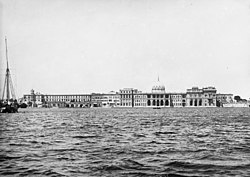Ras El Tin Palace
This article needs additional citations for verification. (December 2009) |
| Ras el-Tin Palace | |
|---|---|
 The palace seen from the Mediterranean Sea, 1931 | |
 | |
| General information | |
| Town or city | Alexandria |
| Country | Egypt |
| Construction started | 1834 |
| Completed | 1847 |
| Design and construction | |
| Architect(s) | Ernesto Verrucci-Bey |
Ras el-Tin Palace, (Arabic: قصر رأس التين Qaṣr Ra's al-Tīn, literally, "Cape Fig Palace"), is a palace on the coast of the Mediterranean Sea in Alexandria, Egypt. It is one of the official residences for a serving President of Egypt. Under the Muhammad Ali Dynasty of Egypt and Sudan, it was a royal palace. Ras el-Tin Palace is the oldest royal Egyptian palace still in use.
History
The palace has a long historical breadth across Egyptian royalty. It is one of few palaces in Egypt that witnessed the early 19th century initiation by Muhammad Ali Pasha (r. 1805-1848) of the long Muhammad Ali Dynasty. Following the Egyptian Revolution of 1952, the palace was where the penultimate monarch of Egypt and Sudan, King Farouk, signed his abdication, and departed from Egypt in exile.
A number of foreign architects and engineers were commissioned by Muhammad Ali Pasha for the design and construction of the palace.[1] Building activities began in 1834, taking eleven years to complete the original design in 1845. Complementary work and construction of additional wings continued two more years until 1847, when it was officially inaugurated.
Style
Ras el-Tin Palace has the shape of a large Italian Renaissance palace, with architectural elements and ornamentation inspired by that era. It was erected on a foundation of 17,000 square metres (4.2 acres), surrounded by elaborate gardens of 12 feddans (13 acres). Fig trees (Arabic - teen) were already on the palace site, inspiring its name Ras Al-Teen. Through the reign of successive kings the complex was used as their residence and the government headquarters during the summer season.
Various rulers made changes to the palace. It was totally reconstructed by King Fuad I in the 1920s, with modern services and redecoration making it similar to the opulent Abdeen Palace (built 1863), the larger royal complex in central Cairo. The redesign and construction was overseen by the Italian engineer Veroci.[2] The palace included a swimming pool with a large attached glass pavilion hall. The famous Italian artist Giuseppe Amisani, painted several artwork of the royal palace. Much of the opulent furniture during this redecoration was supplied by the Parisian ébéniste, François Linke, on a scale not seen since Versailles 200 years earlier.[3]
After the Second World War, King Farouk had a marine pool built on the Mediterranean breakwater. The pool was linked to Ras Al-Teen with a narrow and long paved lane atop the breakwater, with a jeep used to pass through waves breaking over it. The adjacent pool house included a sitting room, bed chamber, fully equipped small kitchen, and rooms for staff and storing recreation and fishing gear.
Current usage
Ras Al-Teen is used as a naval base and for hosting state guests and events in recent years. There is no public museum or grounds access, unlike the Montaza Palace royal gardens and museum, also in Alexandria.
See also
- Giuseppe Amisani, the painter of the Kings
- Royal Jewelry Museum - Fatma Al-Zahra Palace (Alexandria)
- Palaces in Alexandria
References and notes
![]() Media related to Ras el-Tin Palace at Wikimedia Commons
Media related to Ras el-Tin Palace at Wikimedia Commons
